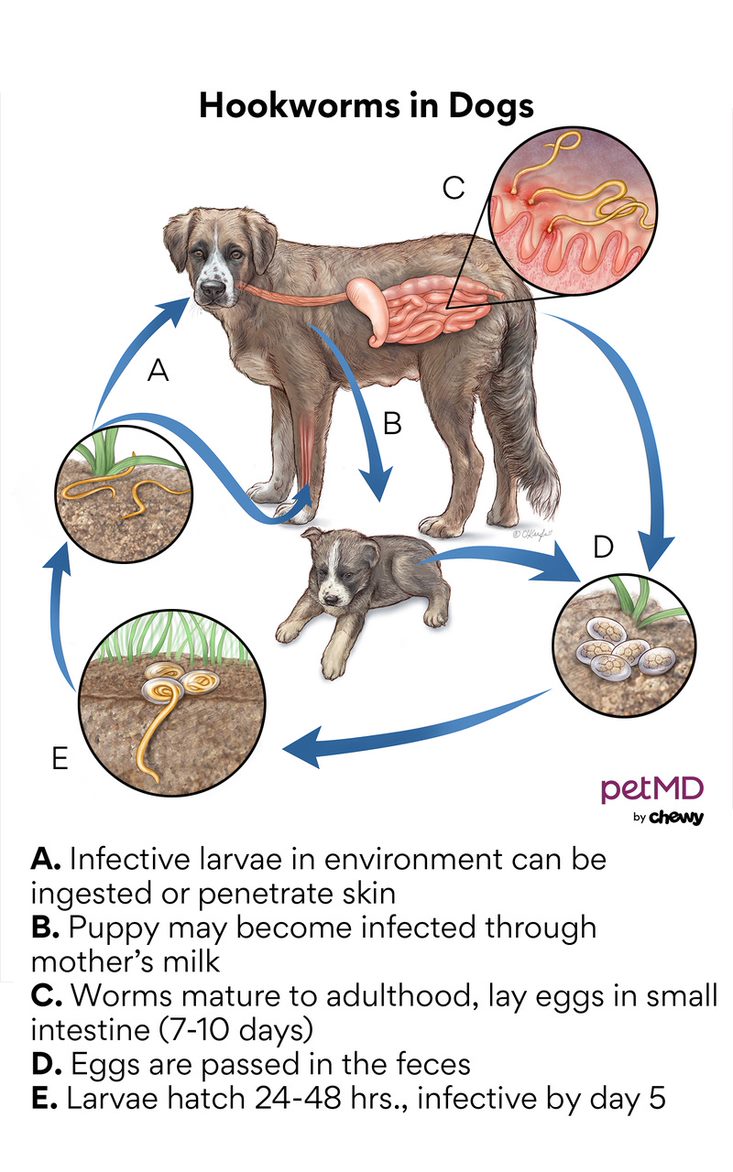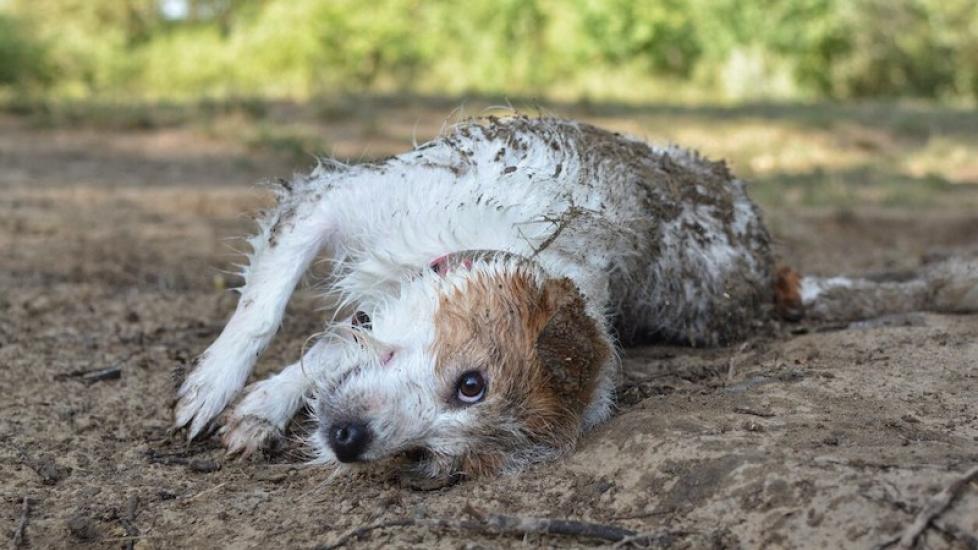Hookworms in Dogs
What are Hookworms in Dogs?
Hookworms—specifically, Ancylostoma caninum, Ancylostoma brasiliense, and Unicinaria stenocephala—are among the most common parasitic infections in dogs, along with roundworms, tapeworms and whipworms. They are a particular cause for alarm because in addition to dogs, they can infect numerous other mammals, including humans.
The parasite gets its name from its bent head and mouthparts, which allow it to “hook” onto the intestinal lining to suck blood or feed on liquefied tissue. Hookworms are found worldwide.
In a recent study conducted in the United States, hookworms were found most recently in the Southeast, where a large proportion of sampled dog parks were infested.
Symptoms of Hookworms in Dogs
Given the life cycle of the hookworm, most symptoms are Gastrointestinal (GI) related. Your dog may experience black, tarry stools, vomiting, decreased appetite and weight loss. Additionally, because the worms feed on blood, your dog may become anemic and experience lethargy, weakness and pale gums. Skin infections, coughing and pneumonia may also be seen, but are less common.
Unfortunately for pet parents, most mature, healthy dogs infected with only a few worms may not show any symptoms and would need to be determined through testing.
Causes of Hookworms in Dogs
A parasite is an organism that lives on or within another organism called the host. There, it is protected and obtains its nutrients, often to the host’s detriment. The adult hookworm lives in the host’s (GI) tract, specifically the small intestine, and feeds off its blood by latching onto the intestines. It mates and reproduces within the GI tract, and the female sheds its eggs into the host’s fecal matter. Once deposited onto the ground/soil, the eggs hatch, go through several developmental stages, and go on to infect others by way of:
-
Penetrating the skin of an unsuspecting host, usually through the feet (most commonly seen in humans and called cutaneous larval migrans or clinically referred to as a creeping eruption.)
-
Ingested either from contaminated soil, other animals’ feces, or eating prey
Once inside the host, the hookworm migrates through the tissues to the lungs. It then can be coughed up, re-swallowed and take another trip through the small intestine to reproduce and continue its lifecycle.
During their migration throughout the body, hookworms can become encysted. This means that they enter a dormant stage and remain inactive for some time, only to periodically “wake up” to begin a destructive cycle once again. One of these wake-up times includes a dog’s pregnancy, when the worms migrate to the mammary glands and are then ingested by the pups. Hookworms can also pass to the pups through the placenta.

How Veterinarians Diagnose Hookworms in Dogs
Most dogs are diagnosed through the examination of feces in a test called a fecal flotation with centrifugation. This is a test that is often conducted bedside in an animal hospital. The feces are first mixed with a chemical and spun down, after which it’s examined under a microscope to look for the presence of the hookworm’s characteristic oval eggs.
The greater the amount of feces examined, the greater likelihood of detection.
Treatment of Hookworms in Dogs
Treatment of hookworm infections in dogs is straightforward. Deworming medications, such as Fenbendazole, Pyrantel, Moxidectin, and Milbemycin are often the treatments of choice, and a second dose is usually administered a few weeks later. Most of these medications are inexpensive.
However, dogs suffering from significant anemia and/or secondary complications, such as pneumonia, will most likely require more extensive therapies, such as:
-
Blood transfusion(s)
-
IV fluids
-
Feeding tubes
-
Iron and/or vitamin supplements
-
Additional medications
-
High-quality and high-protein diets
It’s important to note that the following are more at risk for developing significant illness from a hookworm infection:
-
Puppies
-
Dogs in a crowded environment (shelters, boarding facilities)
-
Dogs that suffer from any other underlying condition
Recovery and Management of Hookworms in Dogs
Fortunately, there are several things you can do as a pet owner to minimize hookworm infections in your dog, including:
-
Ensure your dog has at least twice-yearly examinations and stool exams by your veterinarian, and more often if you have a puppy.
-
Provide your dog with a monthly flea and heartworm preventive product that includes a dewormer.
-
Maintain a sanitary home environment.
-
Feed your dog good-quality dog food.
-
Minimize stress in your dog’s life.
-
Treat any illnesses your dog may have as soon as you notice symptoms.
-
Restrict access to areas of the yard that may be infected. Hookworm larvae are susceptible to cold temperatures and sunlight and can only live in the soil for a few months. Additionally, you can add borax to the soil, which can be an effective control measure to kill hookworm eggs.
-
Pick up any feces in the yard (wearing gloves to avoid being infected yourself) to reduce the risk of transmission.
-
Treat pregnant dogs daily with an approved product during the last trimester and several days into nursing to decrease the transmission from mother to pups.
Are Hookworms in Dogs Contagious?
Hookworms in dogs are contagious to other dogs as well as humans. They are called a zoonotic parasite for this very reason. If your dog has been diagnosed with hookworms, you should take certain precautions to ensure that you don’t also become infected. Preventive measures include:
-
Wearing gloves when picking up and disposing of feces
-
Immediately cleaning areas where your dog has defecated
-
Practicing good hygiene
-
Not sharing bedding with your dog
-
Not walking barefoot or sitting on contaminated soil and sand
-
Consulting with your primary physician if you suspect contracting hookworms from your dog
Hookworms in Dogs FAQs
Can hookworms kill dogs?
Hookworms most certainly can kill dogs, with puppies being most at risk, as well as dogs that live mainly outdoors and are not on a routine deworming schedule.
Can you see hookworms in dog poop?
Roundworms, whipworms, tapeworms and hookworms can be seen in your dog’s feces. Hookworms will look like a thin string in your dog’s feces, but you may not be able to seem them even if your dog has hookworms. It’s important to take your dog in for an examination and bring the stool for proper examination.
How do you know if your dog has hookworms?
Unfortunately, many times you won’t know your dog is infected with hookworms. However, routine deworming products, which are often included in your dog’s heartworm prevention, can be given to treat infection. Routine stool examinations can be and should be performed by your veterinarian. The Companion Animal Parasite Council[1] recommends that dogs be tested for intestinal parasites at least four times in the first year of life and at least two times one year thereafter.
References
Help us make PetMD better
Was this article helpful?
